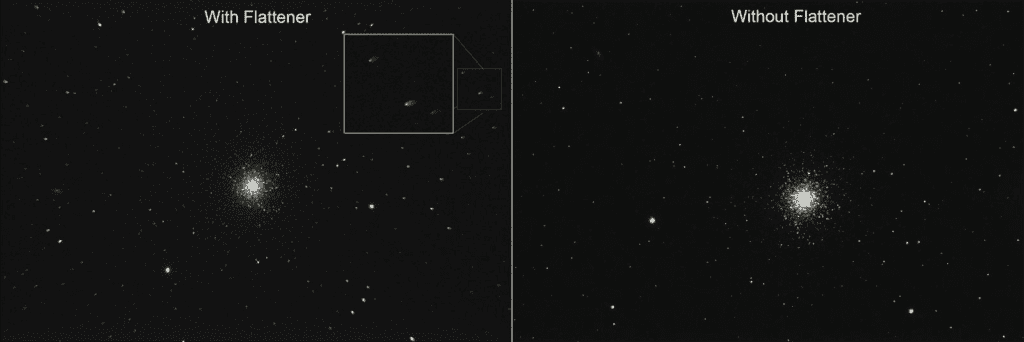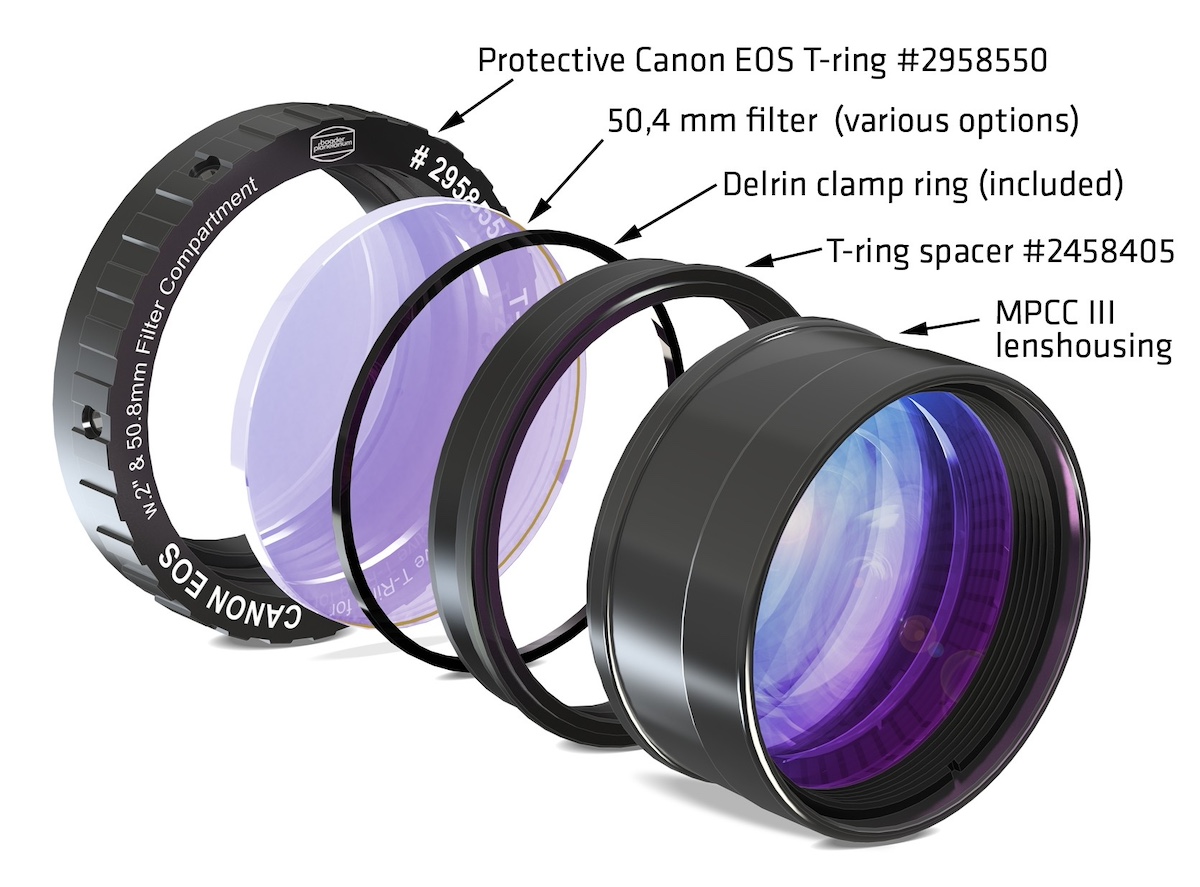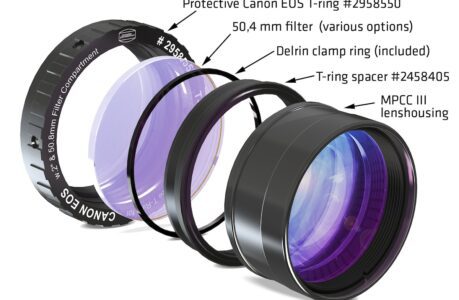In the realm of astrophotography, where every detail matters, achieving stunning, high-resolution images of celestial objects is a pursuit that demands precision and dedication. Amateur and professional astronomers alike invest in advanced equipment to capture the beauty of the cosmos. Among the crucial accessories in an astrophotographer’s toolkit are coma correctors and field flatteners. These two optical devices play pivotal roles in optimizing the quality of astro-images, but they serve distinct purposes. In this comprehensive guide, we will explore the intricacies of coma correctors and field flatteners, highlighting their differences, functions, and how they can elevate your astrophotography experience.
What Is a Coma Corrector?
Understanding Coma Aberration
To grasp the significance of coma correctors, it’s essential to first understand the concept of coma aberration. Coma aberration is an optical defect that occurs in many telescopic systems. It manifests as distorted star images near the edge of the field of view, resembling the shape of a comet’s tail. Coma aberration can seriously compromise the quality of astrophotographs, particularly when capturing wide-angle views of the night sky.
The Role of a Coma Corrector
A coma corrector is a specialized optical device designed to mitigate or eliminate coma aberration in telescope systems. It achieves this by reshaping the light rays that pass through the telescope’s optics, ensuring that they converge precisely on the imaging sensor or film plane. The result is sharper and more uniform star images across the entire field of view.
How Does a Coma Corrector Work?
Coma correctors consist of multiple lens elements carefully engineered to correct the optical distortions introduced by the telescope’s primary and secondary mirrors. These elements counteract the spread of light rays, redirecting them to create pinpoint star images, even at the edges of the frame. This correction is vital for astrophotographers aiming to capture wide-angle shots, as it ensures that stars remain sharp and free from the characteristic comet-like tail.

Benefits of Using a Coma Corrector
- Sharper Star Images: The primary advantage of using a coma corrector is the elimination of coma aberration, resulting in tack-sharp star images throughout the field of view.
- Improved Wide-Angle Photography: Coma correctors are especially beneficial when capturing wide-angle views of the night sky, as they maintain image quality across a broader area.
- Enhanced Visual Observations: Coma correctors can also improve visual observations through telescopes, providing clearer and more accurate views of celestial objects.
- Reduced Post-Processing: With reduced aberrations in your images, you’ll spend less time in post-processing, leading to more efficient and satisfying astrophotography sessions.
Choosing the Right Coma Corrector
Selecting the appropriate coma corrector for your telescope setup requires careful consideration. Factors such as the telescope’s focal length, the size of your camera sensor, and the type of camera you’re using all play a role in determining the correct coma corrector for your needs. Consulting with experts and researching specific models compatible with your equipment is essential to making an informed choice.
Field Flatteners Demystified
Understanding Field Curvature
Field curvature is another optical aberration that affects the quality of astrophotographs. It occurs when the focal plane is curved rather than flat. In such cases, objects at the center of the frame may appear in focus while those at the edges or corners appear blurred or distorted. Field curvature can be especially problematic when using telescopes with fast focal ratios.
The Role of a Field Flattener
A field flattener is an optical accessory designed to address field curvature by precisely flattening the focal plane. By doing so, it ensures that objects across the entire frame are in sharp focus. Field flatteners are particularly valuable when using telescopes with short focal lengths, such as refractors, which are prone to field curvature.
How Does a Field Flattener Work?
Field flatteners, like coma correctors, consist of multiple lens elements that work together to correct optical distortions. These elements reshape the incoming light, compensating for the curvature introduced by the telescope’s optics. The result is a flat, evenly focused image plane that eliminates the curvature-related issues in astrophotography.

Benefits of Using a Field Flattener
- Uniform Image Sharpness: The primary advantage of a field flattener is the consistent sharpness of objects across the entire frame, eliminating field curvature-related distortions.
- Ideal for Short-Focus Telescopes: Field flatteners are especially valuable when using short-focus telescopes, ensuring that these instruments deliver optimal image quality.
- Enhanced Wide-Field Views: When capturing wide-field images, a field flattener ensures that stars and celestial objects remain in focus from edge to edge.
- Reduced Post-Processing: By addressing field curvature in-camera, field flatteners reduce the need for extensive post-processing corrections.
Selecting the Right Field Flattener
Choosing the appropriate field flattener involves considering factors such as your telescope’s focal length, the size of your camera sensor, and the specific requirements of your astrophotography setup. Compatibility with your existing equipment is crucial, so be sure to consult with experts or refer to manufacturer recommendations when making your selection.
Key Differences Between Coma Correctors and Field Flatteners
Now that we have a clear understanding of the roles and functions of coma correctors and field flatteners, let’s delve into the key differences that set these two optical accessories apart.
1. Optical Aberration Addressed
- Coma Corrector: Coma correctors primarily address coma aberration, ensuring that star images remain sharp and distortion-free.
- Field Flattener: Field flatteners primarily address field curvature, ensuring that objects across the entire frame are uniformly focused.
2. Applicability to Telescope Types
- Coma Corrector: Coma correctors are most commonly used with reflector telescopes, which are prone to coma aberration due to their mirror-based optical systems.
- Field Flattener: Field flatteners are typically used with refractor telescopes, which are more susceptible to field curvature, especially at shorter focal lengths.
3. Ideal for Different Photographic Styles
- Coma Corrector: Coma correctors are ideal for astrophotographers who focus on capturing wide-angle views of the night sky, particularly with reflector telescopes.
- Field Flattener: Field flatteners are preferred when astrophotographers aim to capture wide-field images with refractor telescopes, ensuring uniform focus from edge to edge.
4. Image Post-Processing Requirements
- Coma Corrector: When using a coma corrector, the need for post-processing corrections related to coma aberration is significantly reduced, saving time and effort.
- Field Flattener: Field flatteners similarly reduce the need for post-processing corrections related to field curvature, streamlining the image editing process.
5. Compatibility with Camera Sensors
- Coma Corrector: Coma correctors must be chosen based on compatibility with the camera sensor’s size and the telescope’s focal length to achieve optimal results.
- Field Flattener: Field flatteners also require careful selection based on the camera sensor’s size and telescope focal length, ensuring the correction of field curvature is precise.
When to Use Both: Coma Corrector and Field Flattener
In some astrophotography setups, it may be beneficial to use both a coma corrector and a field flattener simultaneously. This dual approach can be particularly advantageous when using reflector telescopes with shorter focal lengths, as they may exhibit both coma aberration and field curvature simultaneously.
By employing both optical accessories, astrophotographers can ensure that their images are free from both coma and field curvature-related distortions. This results in astrophotographs that are not only sharp but also uniformly focused from edge to edge, making this combination a compelling choice for wide-field astrophotography.
Conclusion
In the realm of astrophotography, the pursuit of capturing breathtaking images of the cosmos demands attention to detail and the use of specialized optical accessories. Coma correctors and field flatteners, while serving different purposes, are indispensable tools for achieving exceptional image quality. Understanding their roles, differences, and how they complement various telescope setups is key to elevating your astrophotography game. So, whether you’re gazing at distant galaxies or exploring the beauty of our own Milky Way, harness the power of coma correctors and field flatteners to unlock the secrets of the universe, one frame at a time.
Disclaimer: The links provided below are for informational purposes only and do not constitute an endorsement of any specific product or brand.
Learn More:

